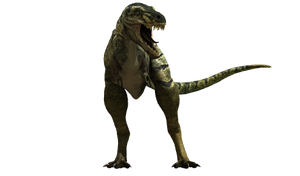| Nanotyrannus | |||||||||||||
|---|---|---|---|---|---|---|---|---|---|---|---|---|---|

| |||||||||||||
Nanotyrannus is an extinct and currently dubious genus of small theropod dinosaur that lived during the Maastrichtian stage of the cretaceous period. It was first discovered in 1941 and classifed as a species of Gorgosaurus (G. lancensis) by Charles W. Gilmore in 1946, at the time known from a relatively complete skull. in 1988, paleontologists Robert T. Bakker, Phil Currie, and Michael Williams, redescribed the skull and assigned it to a new genus called Nanotyrannus lancensis, which translates to "Small Tyrant from Lance (the specific name refers to the Lance Formation, where it was discovered). Since then, more fossils of Nanotyrannus, including a specimen nicknamed "Jane" and "Bloody Mary" have been discovered, which sparked a debate on whether Nanotyrannus was a distinct genus, or was a juvenile Tyrannosaurus.
Nanotyrannus appears in the second episode of Jurassic Fight Club: T. rex hunter, and briefly appears in the twelfth episode: Armageddon.
In the "T. rex Hunter" episode, a pair of juvenile T. rexes are left alone as their parents leave to hunt. Shortly after the parents depart, a Nanotyrannus appears and threatens to kill the juvenile rexes for either food or to eliminate future competition. A battle ensues and one juvenile T. rex is thrown to the ground by the Nanotyrannus, seemingly dead. But as the Nanotyrannus faces the second juvenile T. rex, the first one bites it on the leg, inflicting serious damage and infecting then Nano with the deadly bacteria that dwells within their jaws, reminiscent of modern komodo dragons (this is a myth that was debunked in 2009 with the discovery that komodo dragons possessed venom glands). The retaliating juvenile is quickly killed as the Nanotyrannus snaps its neck. The Nano returns to fight the remaining juvenile, but is halted by the mother returning to the sound of her offspring in danger (the second juvenile T. rex had let out a distress call as the Nanotyrannus killed its sibling). After a brief duel, the Tyrannosaurus kills the Nanotyrannus, , tosses its body to the ground, and tears its corpse apart as a warning to others of its kind.
Description[]
Measuring up to 5.1 meters (17 feet) long, 2.2 meters (7.5 feet) tall and weighing about one ton, this "dwarf tyrant" had a large head, a slim tail, long hind legs, short arms with two-fingered hands and large, strong jaws with sharp teeth.
Fighting Style[]
Faster than Tyrannosaurus rex by 10-20 mph (40- 50 mph), Nanotyrannus had excellent vision and depth perception due to its large, forward-looking eyes. It could chase and overtake its victims with long, fast strides and wound them with its sharp claws and knife-like teeth. And, as in the "T-Rex Hunter" episode, it is claimed to have a bite force that exerts up to half a ton of pressure, which could easily snap the neck of a baby Tyrannosaurus rex.
Diet[]
Like other Tyrannosaurs, Nanotyrannus probably preyed on the duck-billed, herbivorous hadrosaurs that were common in their region at the time.
Trivia[]
- There's some controversy surrounding Nanotyrannus, as featured in National Geographic's special Dinosaurs Decoded (2009): many paleontologists now believe that this dinosaur was actually a juvenile specimen of T. rex as opposed to an independent species.
- However, these evaluations are mostly based on the specimen nicknamed Jane (which is actually a possible juvenile Tyrannosaurus), but not on a specimen called Bloody Mary, which was discovered alongside a Triceratops in 2006 and remained in private hands, but was said by the paleontologist Robert Bakker to be nearly fully grown, although it was still only 20 foot long.
- Moreover, it was said by Bakker that the two skeletons were surrounded by teeth who seemed to be identical with the ones from Bloody Mary, and that it were much more than the specimen carried in her jaws during it's death - a possible evidence for pack hunting, as a single Nanotyrannus would not be able to bring down a fully grown Triceratops alone.
- These are all speculations however, as the specimen isn't able to be analyzed again because it is still in private hands and his owner doesn't let paleontologists look again at the fossils.